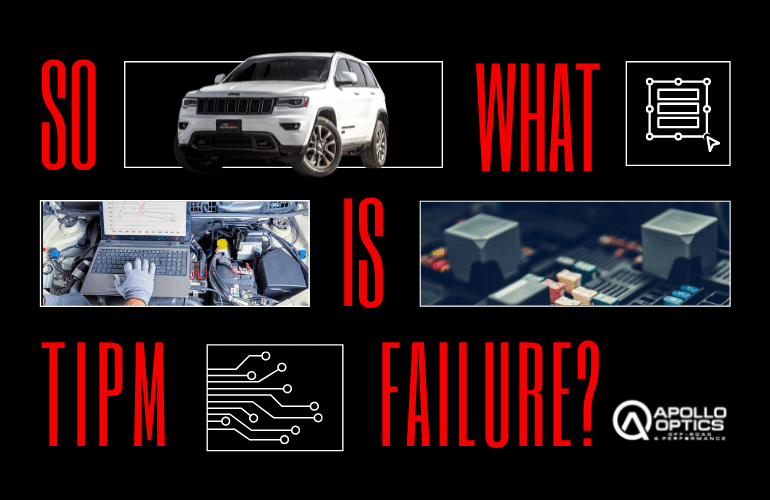 Jeep owners have a lot to be thankful for in terms of overall vehicle durability. Throughout its history, the Jeep, in each of its various forms, has proved resilient beyond comparison. However, even the Jeep itself is not impervious to the occasional breakdown of sorts.
Jeep owners have a lot to be thankful for in terms of overall vehicle durability. Throughout its history, the Jeep, in each of its various forms, has proved resilient beyond comparison. However, even the Jeep itself is not impervious to the occasional breakdown of sorts.
Though hearty by nature, several mechanical/electrical defects have come to plague various Jeep models throughout the years. Perhaps no such issue has received as much negative press as the TIPM-related issues of roughly a decade ago. However, these TIPM problems were far from exclusive to the Jeep itself, as numerous Chrysler vehicles were affected, including the Dodge Nitro, Dodge Durango, Dodge Ram, Dodge Grand Caravan, and Chrysler Town & Country.
What Is a TIPM?
TIPM stands for Totally Integrated Power Module. In the world of Chrysler products, the TIPM serves as the central distribution hub for the bulk of a particular vehicle’s electrical functions. The TIPM contains numerous fuses and relays, which are supplied with power via a feed circuit. This power is then directed through each of these fuses and relays to operate various vehicle functions.
In the case of many late model Chrysler TIPMs, many vehicle functions were powered through an integrated circuit board as well as a series of internally mounted relays. In this form, the TIPM took on the form of a control module rather than a standard “fuse box” style distribution box.
Some of the functions facilitated by proper TIPM operation included but were not limited to the following.
Chrysler TIPM Failures
As genius as the idea of a totally integrated power distribution interface might seem, Chrysler’s execution of such plans proved to be flawed almost from the beginning. The owners of vehicles that featured this technology quickly began noticing strange anomalies in the day-to-day operation of their cars’ various functions.
Many motorists initially described their vehicles as being “possessed”. These vehicle owners began filing service complaints regarding the repeated activation of their vehicle’s lights, wipers, and horns at random times.
Due to the broad range of symptoms that presented themselves, those at Chrysler began to fear that they had a major problem on their hands. However, this situation only steepened in severity as new complaints surfaced. Reports soon started flooding in of new, far more troubling symptoms.
Many consumers also noted that their vehicles were experiencing a wide array of auto safety system-related malfunctions. ABS and airbag restraint system faults became commonplace, as did no-start complaints. However, few TIPM issues were as severe as those associated with fuel pump power loss.
Chrysler TIPMs housed an internal fuel pump relay, which ultimately supplied power to the fuel pump of any vehicle to which it was affixed. In the case of affected Chrysler models, this power supply could be interrupted without any warning. As a result, fuel delivery to the vehicle’s engine would cease, leading to the onset of a stall-out condition.
Much of the concern surrounding such issues related to what would occur in the event of TIPM failure. Defective TIPMs did not always present the exact same symptoms from one vehicle to the next. Further complicating matters was the fact that a perfectly viable TIPM could begin exhibiting symptoms at the drop of a hat and without any prior warning.
Affected Chrysler Models
Perhaps most concerning was the fact that Chrysler’s TIPM issues were not contained to a certain model nor model year. In fact, issues of this type have been recorded across much of FCA’s model line-up and spanned the better part of a decade’s worth of production.
Compiling a complete list of affected Chrysler models is virtually impossible, due to the fact that the manufacturer has denied culpability in the vast majority of cases relating to such matters. However, the following is a list of FCA models that are believed to be susceptible to untimely TIPM failure.
Class Action Lawsuits and Recalls
Soon after initial reports of TIPM-related issues began to surface in 2007, many consumers called upon Chrysler to remedy the situation at hand. However, FCA was reluctant to bear the burden of recall. Soon, litigation was brought forth against the auto manufacturing giant, much of which would carry on for years thereafter.
An onslaught of lawsuits, as well as mounting pressure from numerous consumer business agencies, eventually forced Chrysler into issuing a series of recalls. These recalls varied in context, though the vast majority centered around subsequent TIPM re-programming or replacement.
In almost every case, Chrysler only recalled those vehicles that displayed severe enough TIPM-related symptoms to be deemed a safety liability. In fact, even today, it is widely believed that only a minute number of Chrysler vehicles affected by the era’s TIPM fiasco were ever covered under a recall.
The following Chrysler vehicles were recalled for TIPM-related issues.
TIPM Availability Issues
Further complicating matters related to the above-mentioned recalls was a relative shortage of available replacement TIPMs. Many dealers within the Chrysler network were left scrambling in a bid to repair and return customer’s vehicles to service in a timely manner due to lacking product availability.
During the height of this recall campaign, TIPM units were placed on lengthy backorder, many of which carried an estimated delivery time of more than a month. However, many reports detailed far longer waits of approximately 2-3 months.
This delayed arrival of replacement parts placed further scrutiny upon FCA, as consumers struggled to receive timely service, often being left without reliable means of transportation in the process. In most instances, loaner vehicles were provided at a dealership’s sole discretion or as availability allowed.
Potential Symptoms of a Failing TIPM
While not every Chrysler product of the affected model and vintage will experience TIPM failure, such concerns are frequent enough in nature to warrant close attention. If your vehicle has yet to undergo TIPM replacement, it is important to familiarize yourself with the most common symptoms relating to such failures.
Being aware of these symptoms, should they arise, will allow you to take a proactive role in ensuring that any failure is remedied in the timeliest manner possible. This will also allow you to handle such concerns before the severity of such symptoms increase.
The following are the most common symptoms associated with a faulty TIPM.
What To Do If You Suspect TIPM Failure
If your vehicle begins exhibiting one or more of the symptoms above, you must determine whether or not the TIPM is to blame. If your vehicle is covered under an extended warranty or otherwise part of an active recall, a trip to your local Chrysler dealership will be in store.
However, if your vehicle’s repairs are to take place out of pocket, further diagnostics will be necessary. In many cases, fuses to the affected circuit can be checked with the use of a test light to verify the need for TIPM replacement.
If no power is found on the inlet leg of the fuse that corresponds to the circuit in question, the vehicle’s TIPM is suspect. However, it is also important to verify the continuity of any power supply wires that are found within the affected circuit. This can be verified through the use of a multimeter and a factory wiring diagram.
Additional issues, such as a fuel pump that fails to de-energize when a vehicle is shut off, almost certainly casts doubt on the TIPM unit. In any event, a faulty TIPM must be removed for replacement or repair.
A number of specialty companies now repair faulty Chrysler TIPMs for a fraction of the price associated with a full replacement. Many of these companies also warranty their repairs for a specified length of time. However, a new OEM TIPM can be ordered directly from FCA if desired.
Removing TIPM For Repair/Replacement
In most cases, a vehicle’s TIPM unit can be removed in a rather straightforward manner. This process can be completed by most motorists with a general level of mechanical aptitude with the use of basic hand tools. TIPM removal can typically be completed in under one hour.
While the exact procedure outlining TIPM removal varies slightly from one vehicle to the next, the following steps will outline the basic principles of this operation.
1. Disconnect Battery Cable: Before beginning TIPM removal, it is important to disconnect the vehicle’s negative battery cable from its corresponding battery post. This cuts power to all vehicle electrical circuits, thereby eliminating the risk of shorting or grounding out connections.
2. Gain Access to TIPM: You will now remove all components that prevent direct access to the bad TIPM. In most applications, little removal will be required. However, any components that are removed should be clearly marked for simplified reinstallation.
3. Remove TIPM Power Cable: Next, you will remove the TIPM’s power supply cable, which should be mounted to a stud along its outer expanse. Remove the cable’s hold-down nut with a ratchet and socket before tucking the cable to the side.
4. Remove TIPM from Hold-Down: Most Chrysler TIPMs are secured in place by a set of hold-down clips. These clips can be gently pried outward with the use of a flathead screwdriver. As you pry these tabs outward, lift upward on your vehicle’s TIPM. The module should slide out of place with little effort.
5. Disconnect Remaining Connections: You will notice several electrical connections on the underside of the TIPM itself. The number and style of these connectors will differ by model yet can all be easily removed. Before attempting to remove these connectors, make sure that any lock tabs present have been pried rearward. You will now depress each connector’s lock while gently pulling outward on the connector itself. Alternatively, some TIPM connectors feature a cam-style lock, which must be rotated upward to release.

